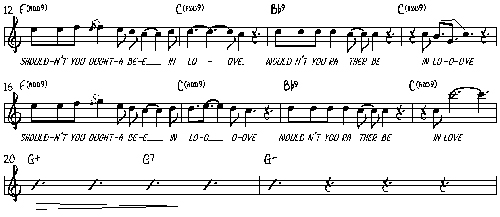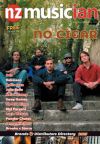X-Factory: Dave Dobbyn – You Oughta Be In Love
X-Factory: Dave Dobbyn – You Oughta Be In Love
Valentines Day will have passed when you get to read this, but in the spirit of the day have a watch and listen to this romantic Kiwi gem. With iconic well crafted tunes, compelling lyrics and patriotic themes, there’s no doubt Dave Dobbyn is a Kiwi songwriting legend. His 1986 tune You Oughta Be In Love (YOBIL) while arguably not as anthemic as Slice Of Heaven, Loyal, or Welcome Home, is undeniably charming – and chock-full of clever songwriting and arranging techniques to boot.
Composed for the NZ film ‘Footrot Flats’, You Oughta Be In Love is a love ballad sung by the cartoon strip’s main human character Wal, a gruff, gumboot, stubbies and singlet wearing farmer, to his girl Cheeky.
The scene where the song is finally unveiled is deeply sweet, with a touch of ironic comedy. Wal, now dressed in a suit, pirouetting about, singing the high pitched, acrobatic melody and lovey-dovey lyrics to his dog = epic feel-good cuteness, right in line with the song’s singular lyrical theme of affectionate attachment. However, the film version’s prolonged verse-verse form (the original first chorus is omitted) means we have to wait a whopping one minute forty seconds to hear that great chorus hook!
Essentially a slow 12/8 pop-rock ballad with an almost ploddy dotted-quarter accent in the rhythm section throughout, many subtle devices are employed to pique the listener’s interest and lift this song from the realm of the ubiquitous to the unique and memorable.
We are drawn into the song with the opening ‘vocal’ synth patch on a rootless Csus2 (key centre tonic chord) which quickly moves to a C major triad before a playful xylophone melody joins over the IV and V chords. Deep warm celli and subtle counterpoint strings bring a sudden lushness and the scene is set – we’re wrapped safely in diatonic land here.
However, Dobbyn uses chord embellishments to propel. The C is always a warmer add9; the G suspends before falling to include the 3rd, adding drama; the voicings and orchestration subtly shift; the strings at the intro move the IV chord a little more. Then at verse two we find a clean electric guitar adding a ninth to the F chord (and an edgier texture too), many other emotive harmonic gems are revealed throughout.
The melody joins at the verse, Dobbyn comfortable in a wide tenor (to high tenor) range over warm underpinning accompaniment. He has room to move here, and move he does – completely at ease, rhythmic phrasing relaxed and natural, gliding over (tricky) larger interval leaps and full to falsetto, back to full voice switches. He also employs tasteful embellishments by elongating what I would assume are written phrases, listen closely to his back-phrasing and phrase extension (without over-dramatising). Line after line of gold as in this great example, ‘Hold on, and give it all you have’ (b.5 to b.7).
Check out the entire second verse and some of the adlibbing on the final chorus for more great phrases.
Back to the pre-chorus where Dobbyn intones ‘Then, here she comes, in walks my baby’, and we move to the relative A minor, the violins adding ninths and tension, before a penultimate secondary dominant D7 chord and a subtle ‘smile’ wafts in on the BVs, lifting us toward the dominant where a great chorus setup follows. G to an F/G to a higher-voiced G and finally a staccato string stab on a G+; fraught and foreboding, a great gasp of silence before the first chorus falls.

 A G+ would normally precede a C chord of some kind, however the chorus surprisingly (and happily) begins on the IV chord (F major), alternating with a double plagal bVII (Bb major) and our C major tonic. We finally get our big hook, and it’s complex and elusive. Try singing it back after one listen exactly in time with Dobbyn!
A G+ would normally precede a C chord of some kind, however the chorus surprisingly (and happily) begins on the IV chord (F major), alternating with a double plagal bVII (Bb major) and our C major tonic. We finally get our big hook, and it’s complex and elusive. Try singing it back after one listen exactly in time with Dobbyn!
The chorus melody continues, tracing more delicious harmonic embellishments along its linear pathway; a ninth on the tonic chord, suspending slightly, while backing vocals harmonise lushly through the chorus, adding colour and rhythmic movement (Ab [b7], C [M9th], and a subtle Eb to D [4th to 3rd] over the Bb9 chord add a touch of wistfulness and also provide a sweeter release to the final C tonic resolve).
Arguably the most dramatic moment of the entire tune is b.14 – we are compelled to follow it toward a conclusion (the resolving tonic chord at b.15). To end the chorus Dobbyn gives us a climactic, shimmering high C (b.19), falsetto style, as the strings descend to a G+ for a two bar tag (b.20 and b.21) a quick full-band diminuendo ensues; preparing the second verse.
While the structure is straightforward (intro | verse | pre | chorus | rinse and repeat) a stripped back 8 bar interlude comprised of the intro / verse chords replaces what would normally be a ‘middle 8’ bridge section and provides a strong dynamic contrast via more sweet string lines, xylophone cuteness and some soft, subtle improvised fills before the final chorus comes crashing back in.
An end double chorus with a bit more oomph and some bells and whistles sees us following the ‘golden ratio’ (ish) model, and that generally equals satisfied listeners. I would put myself in that basket – I recall being an infatuated 11 year old in 1986 – this was my soundtrack back then, and as it has surfaced over the years I’ve always enjoyed it. Maybe I’m a hopeless romantic…
Dixon Nacey is a guitarist, composer, producer and MD, who teaches music at Auckland & Massey University, CPIT in Christchurch, and online at www.jazzguitarlegend.com.


